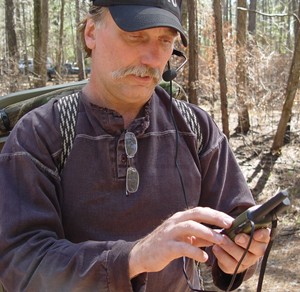Jerry Hestand dropped a 25-pound sack of plaster of paris over his shoulder and set a brisk pace for the Red River. The Bigfoot Bounty Hunters had no problem keeping up on an early spring day. They were a pack of kids on mission: Search for the legendary beast and along the way capture footprints of the many critters inhabiting the rolling hills of North and East Texas.

The tasks of the day were to make plaster casts of as many different animals as they could find, retrieve pictures from a camera trap, and replace the camera’s batteries and memory card. The 16 fourth grade students, some parents and younger siblings hiked a mile or so into the field for the operation.
Hestand is a 14-year veteran fourth grade science teacher at Bells Elementary School. And this is not your typical science club. When Hestand uses the words field trip, he’s being literal. These young scientists sport boots and jeans, or camo, and heft buckets of plaster and sacks of sardines (bait not snacks.)
Hestand carried eco-scientist type high-tech gear in a backpack. A giant smile on his face and binoculars draped around his neck, Hestand watched as his students explored the nature as they came upon it. Periodically, one would exclaim “Wow!” “Look!” or “Ehew, yuck!” and an excited group would form around him or her to examine the find.
The more traditional science and math takes place back in the classroom where the students will measure their specimens and calculate the critters’ sizes. They also research what type of animals’ tracks they’ve captured and information about their habitats and habits.
Before loading the outdoor-skids into cars for the trip to the field, Hestand gathers them into his classroom. This is the scene for the ever-necessary lecture on rules of safety in the out of doors.
“What are the rules?” he asked.
“Stay together. Stay within a grownup’s sight. Wear long pants (some didn’t heed this warning and were sorry). Take water and a snack.” “Watch out for poison ivy.”
And he asked them what were they were looking for?
“Animal tracks!” the students yelled.
“And where will we find them?”
“In the mud,” came their reply in unison.
“Any other rules?”
“Don’t climb over any fences.”
They chose companions for the car trip to some land along the Red River, just a little north and east of their school. A private property owner allows Hestand and his young scientists to use his land. On this field trip day, someone forgot to unlock the gate, so the hike in was a lot longer than planned. That might have meant some anxious moments for parents who expected to meet their children an hour or so later.
The event was closer to three hours. Some of the parents who helped with the transport left early to return students who had siblings in track meets or other events themselves — and reassure other parents that everything was fine, just an unavoidable delay. The remaining team seemed relieved when a dad showed up at the end with a truck and empty flatbed trailer to drive them back to the main road.
But first the group fluttered across the landscape, finding tracks, carcasses, ant hills and many prickly plants. They hit the mother lode when they reached the Red River. They found a place where the animals gathered to take a drink where the river slowed but wasn’t stagnant. The wildlife had worn away the plants and provided the perfect mud field. Hestand demonstrated how to mix plaster of paris to the perfect consistency for casting tracks.
They mixed the white slop enthusiastically, so much so that their clothes were decorated with it.
Their excitement obvious by the hopping up and down and nervous chatter, the youngsters contained their enthusiasm enough to keep from stepping on tracks at the edges. By the end of the day, they successfully had cast “beaver, raccoon, possum, turkey and large water birds, probably blue heron,” Hestand reported in an e-mail Monday.
Students on the field trip were far too busy exploring the wonders of nature to submit to any interviews. But their interest was evident.
After their exercise of casting prints by the river, the group hiked east across a field to a ravine that held a tributary creek to the Red River. This was the site of their first camera trap. Hestand and some of the fathers helped students negotiate the steep bank, about 25 feet high, to reach the camera location. Some found it necessary to test their waterproof capability of their field boots in the creek. Others explored “better” routes up the embankment.
Students who had picked up skeletons and poked at carcasses, showed total disgust as they opened the tins of sardines used to bait the camera traps. The bait has drawn families of wild hogs, a large boar and a doe and her fawn in front of the camera’s lens, Hestand said.
Bigfoot Bounty Hunters came about when students found out Hestand had appeared on the television show “Monsterquest” which airs on the Travel and History channels. The series features scientists investigating mythical creatures and tales. Hestand said he has been a Bigfoot investigator since 2001, when he became a member of the Texas Bigfoot Research Conservancy. His non-fiction interest grew from his love of classic horror tales, in this case “Legend of Boggy Creek” and “Creature from Black Lake.”
When students heard of his television fame, they often asked him about what he had seen on his trips into the woods and swamp lands.
“I told them a few stories during free time and some of them started to look up some of my investigations and contributions to the TBRC,” Hestand said. “Some of them wanted me to take them on an investigation, so I decided to have them meet me after school one afternoon so they could start their own group with my help.”
About 25 students showed up for the first meeting and they’ve gathered every Monday ever since. The students named their group The Bigfoot Bounty Hunters. They had a contest to design a logo, which now appears on T-shirts. The Bounty Hunters set some goals: They want to find an undiscovered animal, be on television, go on campouts and visit different places where Bigfoot sightings have been reported, learn to hike and canoe.
“We want to learn how to use a GPS, use the Internet to research, learn animal sounds and learn how to make a fire,” Hestand said.
Some of the students have accomplished almost all of their goals — and more. On numerous field trips, they have collected dozens of plaster casts of animal prints. They have set up camera traps (digital cameras with night vision lenses that capture images of animals drawn to the area with bait.) They have watched and helped replace batteries and download pictures from the cameras to laptop computers.
“Three students went with me on a trip to Fouke, Arkansas (Bigfoot sighting central and the setting of Legend of Boggy Creek.) and traveled the bayou at night,” Hestand wrote recently. “We found two huge alligator carcasses that poachers had probably shot for fun (lesson in ecology). We have started a skull collection and we go to the Internet to identify the animal. So far we have found coyote, deer, cow and horse.
“We are working on a Facebook page and we plan to have an end of year camp out.”
Parents support the effort with seven accompanying one field trip and others designing the T-shirts. One father on the field trip said he is just so happy to see his kids out in the fresh air and excited about learning.
The students are selling their T-shirts and field guides called “Critters of Texas,” pocket-size books picture animals and their footprints. The funds go to buying camera equipment and other implements for their scientific inquiries.
“We are planning to award ‘merit badges’ next year, example: Bone patch for finding and identifying bones,;(a) track badge, casting excellent track and identify animal; report badge, write an interesting report about a subject related to our research including pictures or illustrations,” Hestand wrote in an e-mail.
Hestand said the fourth graders, as they prepare for promotion to fifth grade, were worried they could no longer be Bigfoot Bounty Hunters.
“I assured them the group would be open to students interested in nature and they would continue to be junior investigators as long as they were willing to spend their time learning about the world around them,” Hestand said.
What are the limits to learning when the whole world is your classroom?
Original article in the Sherman Herald Democrat.
